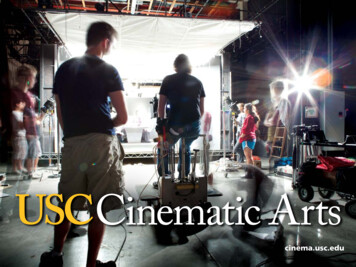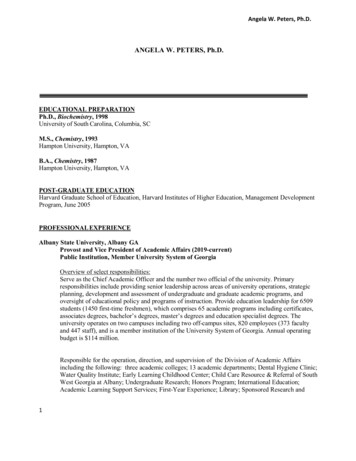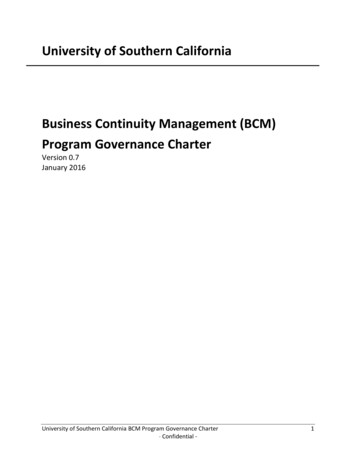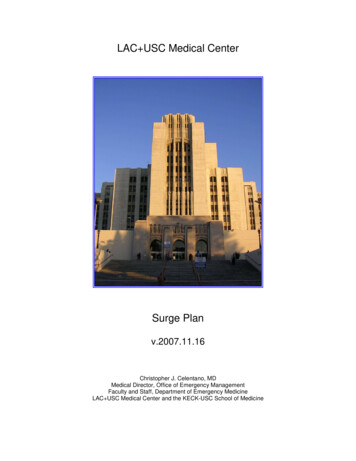
Transcription
cinema.usc.edu
STATISTICS AT A GLANCEUndergraduate Student Body: 876Male: 57 percentFemale: 43 percentEthnicity:Asian/Pacific Islander: 11 percentBlack/African American: 4 percentHispanic: 12 percentNative American/Alaskan: 1 percentNon-Resident Alien: 4 percentWhite/Caucasian: 60 percentUnknown/Other: 2 percentPrograms and Degrees GrantedGraduate Student Body: 715Male: 59 percentFemale: 41 percentEthnicity:Asian/Pacific Islander: 9 percentBlack/African American: 8 percentHispanic: 9 percentNative American/Alaskan: 1 percentNon-Resident Alien: 20 percentWhite/Caucasian: 47 percentUnknown/Other: 7 percentInteractive Media & Games DivisionBachelor of Arts, Master of Fine ArtsFaculty:Full-time: 96Part-time: 219Undergraduate MinorsStaff:Full-time employees: 144Student workers: 499Living Alumni: over 12,000(Number rounded to the nearest 100)The Bryan Singer Division of Critical StudiesBachelor of Arts, Master of Arts, Ph.D.Film & Television ProductionBachelor of Fine Arts, Bachelor of Arts,Master of Fine ArtsJohn C. Hench Division of Animation & Digital ArtsBachelor of Arts, Master of Fine ArtsMedia Arts PracticeBachelor of Arts, Ph.D.Peter Stark Producing ProgramMaster of Fine ArtsWriting for Screen & TelevisionBachelor of Fine Arts, Master of Fine ArtsAnimation & Digital ArtsCinematic ArtsCinema-Television for Health ProfessionalsDigital StudiesGame AnimationGame AudioGame DesignGame EntrepreneurismScience VisualizationScreenwriting
The mission of theUSC School of Cinematic Artsis to develop and articulatethe creative, scholarly andentrepreneurial principles andpractices of film, television andinteractive media, and in doingso, inspire and prepare thewomen and men who willbecome leaders in the field.cinema.usc.edu
SCA PHILOSOPHY & LOCATIONSCA PHILosoPHYSCA LocatIonThe School of Cinematic Arts is situated in the heart of Los Angeles, regarded as theentertainment capital of the world.Within just a few miles of the university are the corporate offices and production facilities of leading motionThe SCA teaching philosophy is builtpicture, television and interactive companies. The city is also home to talent agencies and management firms,on the understanding that people learnindependent producers and new media creators. Archival resources are also in ample supply, affording studentsbest by doing. Additionally, we believethat great ideas arise when theory andpractice are in constant interaction,propelling one another forward. Ouraim is to give students comprehensiveexposure to all facets of film, televisionand interactive media. Our programsare structured to enable students,regardless of their chosen area ofspecialization, to take a wide selectionof courses from across the disciplines.Through this process, critical studiesmajors get behind the camera to makeshort films, writers direct actors tolearn how to craft the best scripts anddirectors immerse themselves in thecanon of work made by the generationswho came before.access to primary-source research materials, as well as films, programs, scripts and other items from which theycan draw insight and inspiration for their own projects.
SCA FACULTYSCA FacuLtYEach SCA faculty member has worked, or is currently working, in theirprofession.As directors, editors, writers, producers, game designers, sound designers, lighting artists,animators and in many other roles, they constitute the power behind everything from box-officeblockbusters, to independent films, to broadcast and cable television hits, to interactive gamesand other new media. Many of our faculty have won top accolades including Oscars, Emmys,Golden Globes, NAACP Leadership Awards, the Humanitas Prize, the Pulitzer Prize and others.They are also members of professional organizations including the Academy of Motion PictureArts and Sciences, the Academy of Television Arts & Sciences, the Society of Motion Pictureand Television Engineers, the Writers Guild of America, the Directors Guild of America, theProducers Guild of America and the American Society of Cinematographers. In the Bryan SingerDivision of Critical Studies, professors and researchers serve on the editorial boards of manyof the discipline’s leading journals and are actively engaged in participating in and organizingconventions, lectures and other events that advance society’s understanding of the creationand cultural impact of film, television and interactive media. Each and every one of the facultymembers takes particular interest in sharing this expertise with their students. And by keepingthe majority of our classes small in size, students have ample opportunity to work directly withthe faculty, engaging in a lively exchange of ideas and creating relationships that often extendfrom the classroom to the profession.cinema.usc.edu/FacultyTOP: Associate Professor Amanda Pope on a documentary shoot in Moscow.RIGHT CLOCKWISE FROM TOP LEFT: Faculty members Eric A. Furie, Georgia T. Jeffries, Professor Mark Harris and Producer Deborah Oppenheimer withtheir Oscars for Into the Arms of Strangers: Stories of the Kindertransport; faculty members Dr. Rick Jewell, Ella Taylor, Tom Sito and Kathy Smith.
SCA FACILITIES, EQUIPMENT AND RESOURCESSCA FacILItIes, eQuIPment anD resourcesOur state-of-the-art complex provides the perfect setting for film,television and interactive media studies.The Cinematic Arts Complex, completed in 2013, is comprised of eight main buildings,totaling 262,500 square feet. The George Lucas and Steven Spielberg Buildings housesome of the School’s essential resources, including the Marcia Lucas Post ProductionCenter, the Ray Stark Family Theatre, which is equipped for 3D presentation, the Danaand Albert R. Broccoli Theatre, as well as numerous specially equipped classrooms andoffices.Adjacent to the Lucas and Spielberg Buildings is the Student Services and AnimationBuilding which houses the Marilyn and Jeffrey Katzenberg Center for Animation, aswell as a screening room, mixing rooms, extensive sound production studio space andadditional classrooms. The Production Services building includes an equipment center,scenery and prop shops, hair and makeup facilities, along with screening rooms,offices and conference areas.The Complex features four industry-standard sound stages, including the SumnerM. Redstone Production Building which houses two soundstages—Redstone 1 andRedstone 2—and the 20th Century Fox Soundstage, housed in two separate buildings.The School’s newest building, The Interactive Media Building, houses the InteractiveMedia & Games Division, the Institute for Multimedia Literacy and the Media Arts Practice Division, as well as programs and curricula focused on interactive architecture,immersive, mobile and environmental media, crowd-sourced cinema, transmediastorytelling, alternate reality games, augmented reality and mixed reality experience.SCA’s other facilities include the 35,000-square-foot Robert Zemeckis Center forDigital Arts, the country’s first and only fully digital training center, and the EileenNorris Cinema Theatre Complex. The Zemeckis Center for Digital Arts currently housesa performance capture studio, an IMAX theatre, four sound stages, four advancedmedia classrooms, as well as Trojan Vision, the award-winning, student-run televisionstation. The Norris Theatre, which seats 365, is equipped for 3-D presentation and THXsound. It serves as the home of the Hugh M. Hefner Moving Image Archive, made upof a broad selection of student, documentary, educational and feature films, and theFrank Sinatra Hall, which houses a large collection of Sinatra memorabilia.cinema.usc.edu/Facilities
Numbering just over 12,000 strong, SCAalumni and friends form a close-knitcommunity both in Los Angeles andaround the world.People who just a few years ago were studying inour classrooms and working in our production areasnow occupy key decision-making posts throughoutthe creative, financial and academic ranks of film,television and interactive media.Through classroom appearances, screenings,Drawing on the breadth and depth of the School’s teachinginternships and mentorships, students can takephilosophy, history, interdisciplinary organization, resourcesadvantage of numerous opportunities to gain fromand sense of community, our alumni have established anthe wisdom and experience of the men and womenenviable track record of success.who have come before them.A mere sampling of those achievements includes:cinema.usc.edu/Alumni Nearly every year for the past three decades, a USCalumnus or alumna has received an Academy Awardnomination. To date, USC alumni have received 289 Oscarnominations, with 82 taking home the cherished statuette. Every year since 1973, at least one USC alumnus oralumna has received an Emmy Award nomination. To date, USC alumni have received 607 Emmynominations, resulting in 129 victories. Of the top-25 highest grossing movies of all time, 23have featured a USC alumnus or alumna in a key creativeor production position. Critical Studies faculty are on the editorial boards ofmany journals, including Discourse, Film Quarterly andTelevision New Media and the division’s Ph.D. graduatesCourtesy of the Academy of Motion Pictures Arts and Scienceshave been appointed to tenure-track positions at a host ofinstitutions including Dartmouth College, the University ofTexas, Austin, as well as in Asia, Africa and Australia. Over 200 festivals each year feature our student films,television programs and interactive media projects. From 2010-2013 USC was voted the #1 game designschool in North America for its graduate degree programby the Princeton Review. This distinction was jointlyawarded to the School of Cinematic Arts’ InteractiveMedia Division and the Viterbi School of Engineering’sDepartment of Computer Science.All statistics cited are current as of June 2013.CLOCKWISE FROM TOM LEFT: Filmmaker George Lucas, B.A. ’66, autographs a student’s shirt at the opening of the new SCA complex; Shonda Rhimes ‘94 attends Commencement; alums Stephen Sommers ‘93,Peter Segal and John Singleton ’90 join Dean Elizabeth Daley for the unveiling of the Hollywood Star at SCA; Lee Unkrich, director of Toy Story 3 receives his Oscar for Best Animated Feature. Of the top-25 highestgrossing movies of all time, 23 have been created with USC alumni in key roles. The revolutionary game console Xbox was co-created by Kevin Bachus ‘90.ALUMNI IMPACTSCA aLumnI ImPact
THE BRYAN SINGER DIVISION OF CRITICAL STUDIESThe Bryan Singer Division of Critical StudiesDegrees Offered: B.A., M.A., Ph.D.The Bryan Singer Division of Critical Studies looks at andengages with all forms of moving image media from ananalytical and historical perspective.Students are exposed to a vast array of content, ranging from blockbuster moviesto avant-garde films to television shows to YouTube clips, and work to decodethe messages and intent behind the explosion of imagery that surrounds us in the21st century. As part of completing a Critical Studies degree, students will examineworld cultures, history and politics; literature, theater, and narrative theory; artand aesthetics; psychology and human behavior; race, ethnicity and gender;business, economics and industry; engineering and technology; and law and ethics.Students in The Bryan Singer Division of Critical Studies work daily with studentsfrom the other seven divisions, and create their own projects, through which theycan explore their own stories and delve beyond the face value of media. Througha curriculum that encourages a great deal of freedom, they will experience everyIt wasn’t until I went intoCritical Studies that I got to seeall the great movies and hearamazing speakers. My technicalknowledge combined with thatknowledge, making a perfectmarriage for me to graduate intofilm directing.—Bryan Singer, Director, X-Men, Theaspect of the cinematic arts, and in doing so, will be uniquely prepared to follow aUsual Suspects, B.A. ’89, The Bryanwide variety of paths after graduation.Singer Division of Critical Studiescinema.usc.edu/CriticalStudies
Probably the most surprising thingabout Critical Studies was that thisdivision isn’t just about art films orhigh culture products. In CriticalStudies, we screen videos on YouTube,we watch the same television showsI’m watching at home and we watchpopular films.—Chera Kee, Associate Professor at Wayne StateUniversity, Ph. D. ’11, The Bryan Singer Division ofCritical StudiesSome of you may have asked, ‘What canI do with a degree in Critical Studies?’ Tothis I would respond simply: ‘What can’tyou do?’ Critical Studies majors, masters,and doctors have become scholars at theleading institutions of media studiesthroughout the world; you have written,produced, and directed films and TVprograms; you have acted in them, writtenabout them, distributed, promoted,programmed and curated them. You arethe Renaissance women and men of thisera, and you will define for us the futurepaths we pursue. —Akira Mizuta Lippit, Ph.D., Chair/Professor,The Bryan Singer Division of Critical StudiesTOP (L-R): Steven J. Ross, Professor of History and Brian Jacobson celebratethe defense of Brian’s dissertation with Dr. Akira Lippit, Chair of The BryanSinger Division of Critical Studies.ABOVE: Students from the Critical Studies Audio Culture Class visit IMAX;Graduating Critical Studies and iMAP Ph.D. students.
FILM & TELEVISION PRODUCTIONFilm & Television ProductionDegrees offered: B.F.A., B.A., M.F.A.The Division of Film & Television Production plungesstudents into cinema’s rich creative process.Students learn all aspects of cinematic storytelling, from writing and producingto directing, sound design, visual effects, cinematography and editing.Working with state-of-the-art equipment and resources that rival or exceedthose of commercial production houses and studios, students can hone theirskills to create a vast array of projects, including episodic television dramas,situation comedies, content for the web and webisodes, music videos,commercials, reality television, documentaries and traditional, narrative films.The Division of Film & Television Production has diversified its offering tokeep up with the cutting-edge technology and techniques being used in theThe fundamental mission of the Film &Television Production Program is to nourishpersonal growth and creative expression throughthe practice of cinema. Our students develop theability to take audiences on emotional journeysusing a wide array of cinematic arts. We work inall formats, including feature film style, televisiondrama, comedy, reality, documentary, avant-garde,music videos, commercials and webisodes. Everystudent will practice the basic art of producing,writing, directing, cinematography, editing andsound, with the goal that they graduate as bothcomplete media makers and well preparedspecialists in their chosen discipline, as well aspersonal artists and creative collaborators.—Michael Taylor, the Kortschak Family Endowed Chair inFilm & Television Productionentertainment industry. From low-budget, DIY features to next generationdigital effects, green screen, digital production design, performance captureand world building, students work hands on with the same technology beingused on professional film and television sets and will be ready to enter the realworld upon graduation.The Production faculty, all active working professionals, offer invaluablehands-on training and guidance from the very beginning of the program.cinema.usc.edu/Production
I think studying in the productiondivision allows you to be grounded in allcrafts while focusing on the one you’regoing to spend the rest of your lifegrowing in. The production program’sunique one-on-one mentorship programwith industry professionals guaranteesyour education is going to continue evenafter you leave the School’s four walls.—Michael Koerbel, M.F.A. ‘12 , Film & TelevisionProductionUSC is the best film school in theworld. When you’re a kid growing up,loving film, that’s where you want tobe. When it came time to pick a filmschool, as soon as I came to the USCcampus, I was like, “Done.” It wasthe first time I saw my kind; peoplelike me.—Jon M. Chu, Director of Step Up 2: TheStreets, Step Up 3D and Justin Bieber: Never SayNever, B.A. ‘03, Film & Television Production
JOHN C. HENCH DIVISION OF ANIMATION & DIGITAL ARTSThe John C. Hench Division of Animation & Digital ArtsDegrees Offered: B.A., M.F.A.Minor Offered: Animation & Digital Arts, Science VisualizationThe John C. Hench Division of Animation & Digital Arts (DADA)is devoted to providing its students with the tools, theory andsupport to fully explore their creative potential as animators.The field of animation has evolved to encompass everything from traditional, characterbased storytelling, to abstract and experimental work, and utilizes techniques includingpainting and drawing by hand, stop motion and cutting-edge digital design. At DADA,students will delve into a rich and vibrant curriculum that explores every possible aspectof art in motion.As feature animation takes on more characteristics of live-action cinema and liveaction cinema becomes more hybrid, the animator’s role is changing and growing. Theprocesses of live-action and animation are conjoined through the script, the actors’performance and the understanding of cinematic language. The animators’ fluency intechnology allows them to participate, and fulfill their role in the collaborative creativeprocess. DADA offers courses across the spectrum of animation and digital arts, includingCharacter Animation, Performance Capture, Research, Visual Effects, Motion Graphics,Experimental Animation, Documentary Animation and Visualizing Science.The Marilyn and Jeffrey Katzenberg Center for Animation includes classrooms, figuredrawing facilities, an animation library, animation camera rooms, stop motion stages,lounge areas and other resources. The area will be devoted to the instruction of visualeffects, 2D and 3D animation and stop motion animation formats.cinema.usc.edu/AnimationWhether their goal is to work in the industry orforge their own path, students leave our programamply prepared to make their own uniquecontributions to an art form of animation, digitalmedia and visual effects, the development ofwhich has mirrored the evolution of the humanmind. —Kathy Smith, Chair of The John C. Hench Division ofAnimation & Digital Arts
As an animation student, I have beenintroduced to the many methods ofanimation, from 2D and 3D characteranimation to live action compositing withCG integration. I have also been equippedwith an outstanding theoretical backgroundin animation and visual effects. Both ofthese areas have provided me with a goodfoundation for all of my work. Lastly, I havelearned storytelling tools both for animationand film, better ways of expressing thesestories visually and the technical aspect tobring my imagination to life on the screen. —Jesse Doyle, B.A. ‘12, The John C. Hench Division ofAnimation & Digital ArtsWhat is animation? It’s possibly the most open-ended,undefined visual medium there is. Its boundariesshift with popular culture, software developmentand the rapidly expanding moving image landscape.As the cutting edge of art and communication, it’simportant to empower students with not only thenewest tools, but the ability to see and expresscontent that’s relevant to our contemporary culture.—Mike Patterson, DGA, SCA Associate Professor
INTERACTIVE MEDIA & GAMESInteractive Media & GamesDegrees Offered, B.A., M.F.A.Minors Offered: Game Animation, Game Audio, Game Design, Game EntrepreneurismFrom 2010-2013, USC was voted the #1 game design schoolin North America for its graduate degree program by thePrinceton Review. This distinction was jointly awardedto the School of Cinematic Arts’ Interactive Media &Games Division and the Viterbi School of Engineering’sDepartment of Computer Science.The Interactive Media & Games Division (
John C. Hench Division of Animation & Digital Arts Bachelor of Arts, Master of Fine Arts Interactive Media & Games Division . the Writers Guild of America, the Directors Guild of America, the . the majority of our classes small in si











